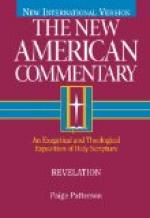There is singular variation in the readings of the name of the scene of the miracle in the three evangelists. According to the reading of the Authorised Version, Matthew locates it in the ’country of the Gergesenes’; Mark and Luke, in the ‘country of the Gadarenes’; whereas the Revised Version, following the general consensus of textual critics, reads ‘Gadarenes’ in Matthew and ‘Gerasenes’ in Mark and Luke. Now, Gadara is over six miles from the lake, and the deep gorge of a river lies between, so that it is out of the question as the scene of the miracle. But the only Gerasa known, till lately, is even more impossible, for it is far to the east of the lake. But some years since, Thomson found ruins bearing the name of Khersa or Gersa, ’at the only portion of that coast on which the steep hills come down to the shore’ (Smith, Historical Geography of the Holy Land, p. 459). This is probably the site of the miracle, and may have been included in the territory dependent on Gadara, and so have been rightly described as in ’the country of the Gadarenes.’
Matthew again abbreviates, omitting many of the most striking and solemn features of the narrative as given by the other two evangelists, and he also diverges from them in mentioning two demoniacs instead of one. That is not contradiction, for if there were two, there was one, but it is divergence, due to more accurate information. Whether they were meant so or no, the abbreviations have the striking result that Jesus speaks but one word, the permissive ‘Go,’ and that thus His simple presence is the potent spell before which the demons cower and flee. They know Him as ‘the Son of God’; a name which, on their lips, must be taken in its full significance. If demoniacal possession is a fact, there is no difficulty in accounting for the name here given to Jesus, nor for the sudden change from the fierce purpose of barring an intruder’s path to abject submission. If it is not a fact, to make a plausible explanation of either circumstance will be a task needing many contortions, as is seen by the attempts to achieve it. For example, we are told that the demoniacs were afraid of Jesus, because He ‘was not afraid of them,’ and they knew Him, because ’men with shattered reason also felt the spell, while the wise and the strong-minded often used their intellect, under the force of passion or prejudice, to resist the force of truth.’ Possibly the last clause goes as far to explain some critics’ non-recognition of demoniacal possession as the first does to explain the demoniacs’ recognition of Jesus!
To the demonic nature Christ’s coming brought torture, as the sunbeam, which gives life to many, also gives death to ugly creatures that crawl and swarm in the dark. Turn up a stone, and the creeping things hurry out of the penetrating glare so unwelcome. ’What maketh heaven, that maketh hell,’ and the same presence is life or death, joy or agony. The dear perception of divine purity and the shuddering recoil of impotent hatred from it are surely of the very essence of the demonic nature, and every man, who looks into the depths of his own spirit, knows that the possibilities of such a state are in him.




